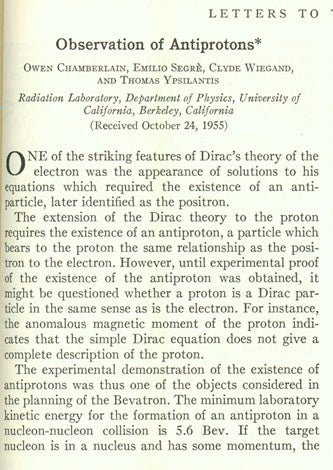
Observation of antiprotons.
Publisher Information: 1955. First edition.
Discovery of the Antiproton
Chamberlain, Owen (1920-2006), Emilio Segrè (1905-89) et al. Observation of antiprotons. In The Physical Review, 2nd series, 100 (1955): 947-50. Whole number. 763-979pp. 268 x 202 mm. Original printed wrappers, vertical crease in back wrapper. Boxed.
First Edition, journal issue. Segrè and Chamberlain, colleagues at the University of California, Berkeley, shared the 1959 Nobel Prize in physics for their discovery of the antiproton, a particle with the same mass and spin as the proton but with opposite charge and magnetic moment. Such antiparticles had been predicted in 1928 by Dirac's relativistic theory of the electron, and the first such particle, the positron, had been discovered by C. D. Anderson in 1932. Several rival groups at Berkeley also entered the antiproton hunt, but the Segrè team's experimental ingenuity insured its triumph:
"I decided to attack the problem in two ways. One was based on the determination of the charge and mass of the particle. The other concentrated on the observation of the phenomena attendant on the annihilation of a stopping antiproton. The stopping antiproton and a proton of the target should mutually annihilate each other, and the rest mass of the two particles should transform itself in one of many possible ways into other particles such as pions. These would leave tracks in a photographic emulsion and the annihilation would thus become evident. . . .
"We started the run on August 25, 1955, and after a few days of tuning up, we began observing antiproton signals. We based the identification on measurement of the velocity, momentum, and charge of a particle. The signals for velocity were oscilloscope traces recording the passage of a particle through a velocity-selecting Cerenkov detector. . . . We detected about one antiproton for every few hundred thousand other particles crossing our apparatus. . . . We decided to write a letter to the Physical Review and an article for Nature. . . . The mass-spectrograph experiment concluded on October 1, 1955, having proved the existence of the antiproton, and soon thereafter the emulsion work confirmed it" (Segrè, A Mind Always in Motion, pp. 256-57).
Book Id: 40520Price: $1,500.00
